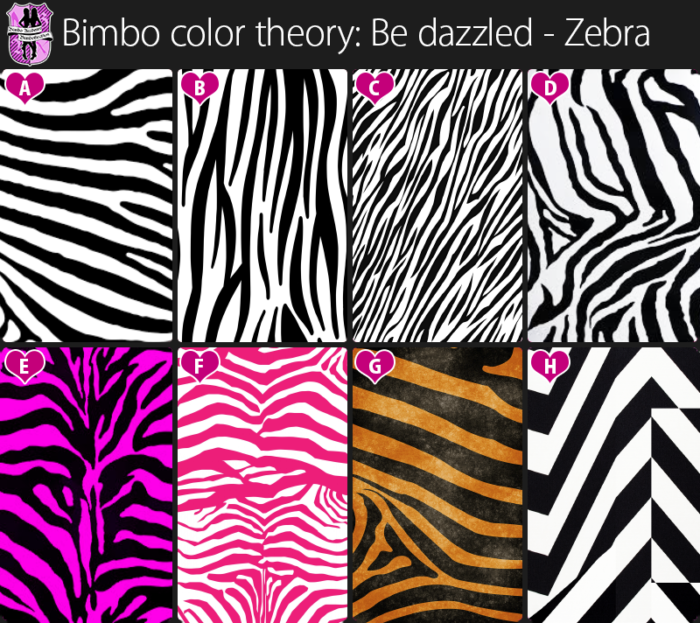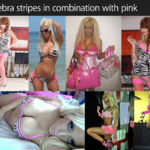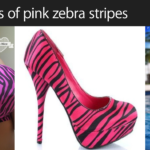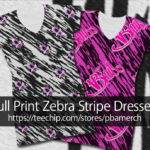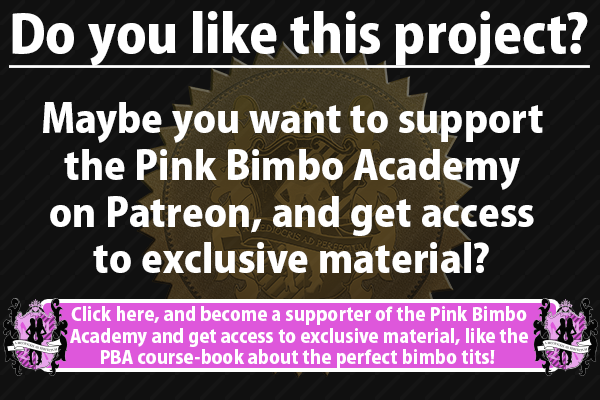See amazing dresses with zebra stripes, specifically created for bimbo dolls! Also in pink!
“Hidden in plain sight.” – U.S. Navy
Now, after we covered the colors “black” and “white“, we have opened the door to a whole new area of bimbo usable patterns and topics. Upcoming articles will be about “contrasts” and of course, within the frame of our bimbo cosplay series, cow-patterns and hu-cows. The pattern we will talk about today works so well because of its high contrast, but is more connected to the “leopard pattern” we talked about some time ago and therefore part of our mini sub-section “animal prints” in this series “bimbo color theory”. The zebra stripes, todays topic, is a rather spectacular natural texture and has puzzled scientists for decades. Even today, it is not quite secured, how and why this unique camouflage evolved with the African equids (Equus quagga), with many different theories and speculations going around. But let us talk about how the pattern is actually constructed before we deal with some of its very special properties, the theory and the benefits for bimbos:
Zebra stripes are composed of two very contrasting colors, the “base color” (usually black) and the “stripes” (usually white) (See “A – D” above). The stripes are normally aligned in a vertical striping pattern (which has some benefits for bimbo dolls, more on that later) (“A” above), with a very organic, smooth shaping, mostly even clearances to each other and sometimes ramifications or recesses. This fairly easy to understand composition results in astonishing and puzzling patterns, often perceived as much more complicated and complex in its entirety, than it seems if individual parts are monitored closely. This property might very well be the key to the question why this camouflage evolved on an animal, that is vulnerable and defenseless in the abstract, and represents one of the main preys of deadly hunters like feline predators, crocodiles and many others. Although evolution and nature often used conspicuous, brash and popping colors and patterns on mostly harmless animals to lead its carnivores to believe in the venomousness or dangerousness of said animal to deter those predators, it is pretty save to say, that this effect doesn’t play a big role here. Instead, it is very likely, that the already mentioned, “puzzling effect” of the zebra stripes is the main reason for this very striking texture – so it is no wonder, that this effect is the determining factor in the two most propable hypotheses, scientists can come up with, on the question of “why did this attention drawer turn out to be so useful?” So, how does that work? The main idea is to utilize the puzzling and complex seeming appeal of the contrasting stripes, to disrupt the outline of an individual animal and make it visually blend with vertically growing grass and its surroundings, as well as with its gregarious animals (zebras travle in big herds of up to 30 members) – especially when they are on the move. Even with those animals standing still, it can become quite difficult to separate individual specimens, which becomes even harder when rapid motion blurs the shapes even more. In addition, the dazzling texture of the zebra stripes, can make it very difficult for a predator to tell in which direction, which animal runs, how fast it is, how many specimens there are and what their current position is. This optical illusion is very similar to “the wagon-wheel effect” and “the barberpole illusion“, both effects that fool the brain with contrasting stripes/elements in motion – an effect that humanity used all the same, to prevent getting killed in the two most atrocious and nightmarish conflicts history has ever seen:
Dazzle camouflage
“It could distort the eye, like happens in the animal world. It can trick you into thinking you aren’t going where you are.” Zebra stripes were particularly successful if they were painted well.” – Jim Bruns ( “Razzle Dazzle: The Art and Science of Ship Camouflage“ )
During World War I, British marine artist Norman Wilkinson had an idea: What if there was an alternative to the standard paint-scheme of British ships, that didn’t work really well in hiding those ships from German submarines, which sank disastrous amounts of gross register tons in those times? Default camouflage wasn’t really able to hide ships under different lighting- and weather conditions or in front of different skies and backgrounds, so maybe there wasn’t a possibility to hide them at all? Maybe it would be a far better idea, not to try to hide them, but to make it just more difficult for the Germans to hit them? What followed, was the invention of the “dazzle camouflage“, or “razzle dazzle” how Americans called it (see “H” above), who adapted this technique, after the British had indications for the success of their new camouflage, which stood in service till the heyday of the Second World War, until it became obsolete, because hits on warships and freighters were made with electronic auxiliaries, like radar and sonar by then, and not solely with the human eye anymore – an amazingly interesting and fascinating story, which I would encourage you to read, but nothing we will talk about here in detail. What is important to us, however, are the results, the general idea and the conclusions we can draw from this story. The idea behind the dazzle camouflage was heavily influenced by the effectiveness of the zebra stripes, so it is no wonder, that there was a bewildering likeness between these two textures, with some additional changes, to account for the more geometrical superstructure of ships in comparison to the more organic shapes of animals, but the general intention remained the same:
“At first glance, dazzle seems an unlikely form of camouflage, drawing attention to the ship rather than hiding it. The approach was developed after Allied navies were unable to develop effective means to hide ships in all weather conditions. The British zoologist John Graham Kerr proposed the application of camouflage to British warships in the First World War, outlining what he believed to be the applicable principle, disruptive camouflage, in a letter to Winston Churchill in 1914 explaining the goal was to confuse, not to conceal, by disrupting a ship’s outline. Kerr compared the effect to that created by the patterns on a series of land animals, the giraffe, zebra and jaguar.” – Wikipedia (intended purposes of dazzle camouflage).
“Taking up the zebra example, Kerr proposed that the vertical lines of ships’ masts be disrupted with irregular white bands. Hiding these would make ships less conspicuous, and would “greatly increase the difficulty of accurate range finding.“” – Wikipedia (intended purposes of dazzle camouflage).
And yes, like it had to be expected, “Dazzle ships” were attacked in 1,47% of sailings, compared to 1,12% for uncamouflaged ships, showcasing the increased visibility of those ships and the elevated attention they got, but only 41% of those attacked dazzle ships sunk, in comparison to 52% of the uncamouflaged. The U.S. Navy had even better results: After they introduced the “razzle dazzle” to many ships of their fleet, only 18 camouflaged ships were destroyed, facing 78 annihilated ships without the razzle dazzle, proving the effectiveness of the zebra stripes. (See here.)
Benefits for bimbos
So, what did we learn from this? Well, it is obvious, that this texture is not meant to hide something, which has been proven and should be crytsal clear: High contrasting colors in puzzling and dazzling patterns do generate increased attention and interest – perfectly convenient for bimbos, and one of the reasons most “normal girls” are pretty reluctant by the idea of dressing in this pattern. Zebra stripes do generate attention and attentiveness, even more so, because of their puzzling effect, which is because the human brain finds it interesting and wants to make sense of this dazzling and distracting interaction of puzzling shapes and contrasting colors. Everybody keeps looking at girls dressed in these styles and people tend to linger over the sight of bodies wrapped in clothes with these textures. This alone is reason enough for bimbos to wear zebra stripes whenever possible, because a doll should generate as much attention and draw as many eyes on her as possible, but there are even more reasons. As we already stated, in our articles about the colors black and white – these non-chromatic colors have one very strong advantage over every other color: They can be combined with absolutely every other color, without the undesirable clash many different chromatic colors (especially complementary colors) have! This means, that default zebra stripes can be worn with at least one other color in addition, which spices up the complete style even more. An extremely “bimboish” combination is, of course, a mixture of zebra stripes and bright pink, which works terrific and amazingly well – it can’t get more “bimboish” (you can see some amazing examples above), black and white zebra stripes let the pink pop even brighter and let it stand out even more! The next benefit is, again, a subliminal message you can send to everyone around you: While we have talked about the “predator-like”, feline appeal of leopard prints, which can summon a very distinct and special sexual desire in many men, zebra stripes can generate something similar, but with a completely different perspective: By dressing in zebra stripes, you mark yourself as prey, calling for attention, which can only be understood in one way by many men: You are there to get hunted down, dragged into the bedroom and fucked until the sun rises. This deliberate exhibition as “prey”, with the goal to be hunted and owned, has a very strong effect on many men, and calls for their hunting instincts. This can be VERY effective! Something every bimbo should pay attention to, however, is the fact, that despite the natural specification, the stripes shouldn’t be vertically arranged, which is because of the common misbelief, that vertical stripes let you appear slimmer than you actually are, which turned out to be fundamentally wrong. The Helmholtz illusion shows us, that an object with horizontal stripes is always perceived taller and narrower than an identical object made up of vertical lines. This means, that if you are wearing a dress with zebra stripes, you should make sure, that the lines are angled by at least 45°. This will let you appear slimmer and taller.
Variations and usage
The best combination a bimbo can wear, is a combination of default, black and white zebra pattern (“A – D” above), with bright, popping pink areas or accents. However, there are several other variations of zebra stripes, which can be used by bimbo dolls. The canvas color (usually black) can be changed to another color (like, for example, pink), while the stripe color remains the same (white) (“F” above). This is also possible vice versa (canvas: black, stripes: other color) (“E” above), as long as the contrast ratio is high enough to let every color stand out. Another possibility is a slight alteration of the shape and alignment of the stripes, by a simultaneous change of the background color, to, for example, golden or yellow, which will result in a “tiger stripe” pattern. While the main construction of the textures remains the same, the message you are sending is more similar to the message of the “leopard pattern“, but also acceptable for a bimbo doll (“G” above). Interestingly, tiger stripe patterns were also confirmed in their effectiveness by the U.S. military, during the Vietnam war, when U.S. special forces made use of this camouflage to merge with the jungle around them. This pattern is featured by Cpt. Willard (Martin Sheen) in perhaps the greatest movie ever made, “Apocalypse Now”. Back to bimbo related usage: Also, the “dazzle camouflage” (“H”) can be used as an attention grabber. These patterns can and should be used on any type of fashion object a bimbo can possess: High heels with zebra stripes, stockings, lingerie, bras, panties, bikinis, skirts, tops, dresses, accessories, corsets, bags, purses, and so on, and so on, are available with zebra patterns, and every bimbo should have at least one of those items of each kind. Be assured: Wearing zebra stripes will make you the center of attention and let your outfit and style really stand out. Combine it with bright, popping colors (like pink) and enjoy a style that screams bimbo like no other. No man will be able to resist. This is why I created special dresses for the bimbos and bimbo trainees among you, which you can see here. These dresses are covered with a complete zebra print, angled at 45°, in either black/pink, or white/black. If you don’t already have a zebra pattern dress – it is high time for you to get one of these. In addition, I created pillows and even a towel for you, with the same print 😉 – So, what are you waiting for?

